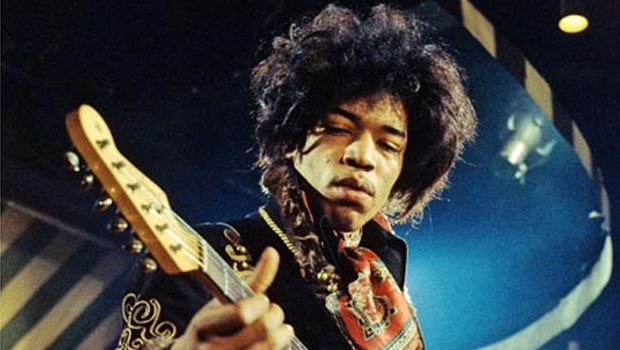Five's Company: Pentatonic-Based Accompaniment Parts

The pentatonic scale most definitely has a place in the lead arsenal of any guitar player, but does it have a role in rhythm work? Clearly, as heard from players like Jimi Hendrix, Billy Gibbons, John Frusciante and Tom Morello, among others, it does.
In fact, regardless of your style, there’s a wealth of single-note riffs, double-stop moves, and chordal embellishments lurking within the scale. Squeeze these sounds between the cracks of basic chord shapes and you’re instantly a more interesting rhythm player.
Before we get to the riffs, let’s examine the nuts and bolts. Like many other scales, the pentatonic comes in two basic flavors: major and minor. To compare, E major pentatonic is built from the 1st, 2nd, 3rd, 5th, and 6th notes of the E major scale (E–Fs–Gs–A–B–Cs–Ds), while E minor pentatonic is built from the 1st, f3rd, 4th, 5th, and f7th tones of the E minor scale (E–Fs–G–A–B–C–D).
Minor pentatonic is most commonly used in blues and rock; major pentatonic, in R&B and country. Regardless of style, these scales sound most effective when played in short note groupings, on small pockets of the fretboard, generally spanning no more than three strings. Keep this in mind as you sample the following figures.
Blues Moves
Many blues riffs are derived from pentatonic bass lines that imitate a pianist’s left-hand playing. Fig. 1, a nod to the fingerstyle country blues of legends like Blind Lemon Jefferson and Blind Blake, is sculpted from an E major pentatonic bass line. Check Fig. 2 for a more contemporary blues application—an E minor pentatonic riff inspired by the Buddy Guy and Stevie Ray Vaughan versions of “Mary Had a Little Lamb.”
Single Notes
Countless rock riffs are based upon fragments of pentatonic scales. The next few passages, however, are examples featuring the entire five-note scale: Jimi Hendrix’s signature line in “Purple Haze” [Fig. 3] and Joe Walsh’s spiraling moves in the Eagles’ “Life in the Fast Lane” [Fig. 4] are both constructed from the E minor pentatonic scale.
Fig. 5 is similar to the wicked riff that kicks off Guns N’ Roses’ “Welcome to the Jungle,” in which guitarist Slash rips through the entire B minor pentatonic scale (B–D–E–Fs–A) using pedal point—repeating the 4th-fret B as notes change below. Meanwhile, for an example of a fragmented pentatonic riff, look to Fig. 6, modeled after Rage Against the Machine’s Fs minor pentatonic (Fs–A–B–Cs–E) gem “Guerrilla Radio.”
Many great funk figures contain pentatonic notes played between the cracks of chord stabs and string mutes. Approximated in Fig. 7, for example, is James Brown’s E minor pentatonic–based “Mother Popcorn.” And Fig. 8 illustrates a G minor pentatonic (G–Bf–C–D–F) funk riff reminiscent of Leo Nocentelli’s work in the Meters’ “Look-Ka Py Py.”
Double Stops
Lots of late-’70s and early-’80s rock classics revolve around double-stop pentatonic riffs. Inspired by ZZ Top’s “Sharp Dressed Man,” Fig. 9 contains some 4ths within the A minor pentatonic scale (A–C–D–E–G). Fig. 10, inspired by the riffs of groups like Kansas and Styx, shows a linear example, with note pairs moved along strings 3–4 against an open-A drone.
But perhaps the ultimate example of double-stop pentatonic in rock is Mark Knopfler’s fingerpicking on Dire Straits’ mega-hit “Money for Nothing,” composed primarily of 4ths and 5ths within G minor pentatonic [Fig. 11].
Chord Embellishments
In the R&B-based styles of Curtis Mayfield, Steve Cropper, and Jimi Hendrix, you’ll find pentatonics used in double- and triple-stop fills—see Fig. 12, for example, in which C major pentatonic (C–D–E–G–A), G major pentatonic (G–A–B–D–E), and A minor pentatonic chord partials are played around C, G, and Am chords, respectively.
Interestingly, in country music, a similar approach is used to dress up open-position “cowboy” chords. As depicted in Fig. 13, single notes within G major pentatonic and C major pentatonic are hammered on and pulled off between the upper strings of G and C chords.
Jazz Comping
Contrary to popular belief, jazz comping isn’t all about altered 7th chords. In one-chord modal vamps, modern-jazz giants like Mike Stern, Scott Henderson, and Joe Diorio might combine handfuls of notes within pentatonic scales to create chord sounds like those seen in Figs. 14A–D.
All of these shapes derive from A minor pentatonic. This comping concept is highly practical because it works in any minor mode (Dorian, Phrygian, and Aeolian), since minor pentatonic omits the 2nd and 6th scale degrees (the tones that vary between minor modes). Fig. 15 is built on 3rds, 4ths, and 5ths in A minor pentatonic (beats 1–2 throughout), alternating with Ef major pentatonic (Ef–F–G–Bf–C) note pairs—the result of tritone substitution (pitches borrowed from a chord sitting a f5 away from the tonic). Use this passage as a cadenza to end any standard in A minor—like “What Are You Doing the Rest of Your Life” or “Black Orpheus.”
Get The Pick Newsletter
All the latest guitar news, interviews, lessons, reviews, deals and more, direct to your inbox!
A singer-songwriter/multi-instrumentalist/film composer, Musician's Institute instructor, and author of 50+ transcription/instructional books, Dale Turner is also Guitar World's "Hole Notes"/"Acoustic Nation" columnist, and the former West Coast Editor of Guitar One magazine. Some of Dale’s old, weird, rare, and/or exotic instruments are featured in his score for WEEDS, the first animated short completed within the Filmmakers Co-op at Disney Feature Animation. His most recent CD, Mannerisms Magnified, was praised by Guitar Player magazine for its "Smart pop tunes that are crammed with interesting guitar parts and tones ... Like what the Beach Boys might do if they were on an acid trip that was on the verge of getting out of control. Yeah!"
“There are so many sounds to be discovered when you get away from using a pick”: Jared James Nichols shows you how to add “snap, crackle and pop” to your playing with banjo rolls and string snaps
Don't let chord inversions bamboozle you. It's simply the case of shuffling the notes around








![Joe Bonamassa [left] wears a deep blue suit and polka-dotted shirt and plays his green refin Strat; the late Irish blues legend Rory Gallagher [right] screams and inflicts some punishment on his heavily worn number one Stratocaster.](https://cdn.mos.cms.futurecdn.net/cw28h7UBcTVfTLs7p7eiLe.jpg)


